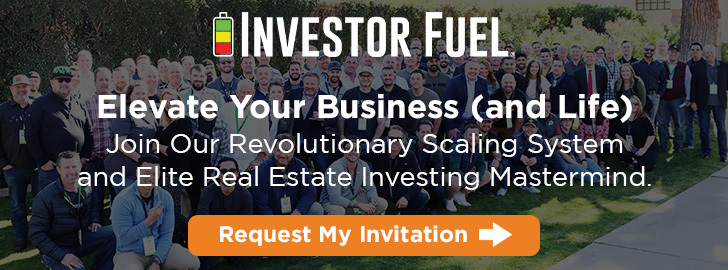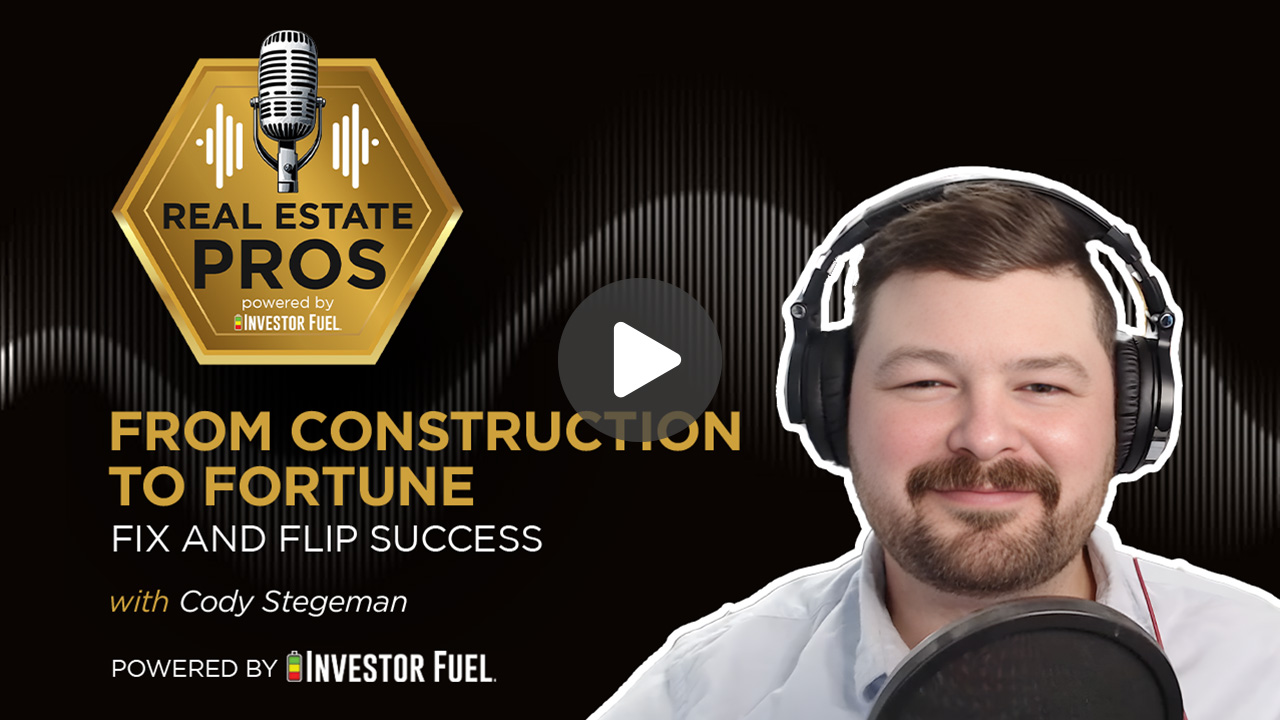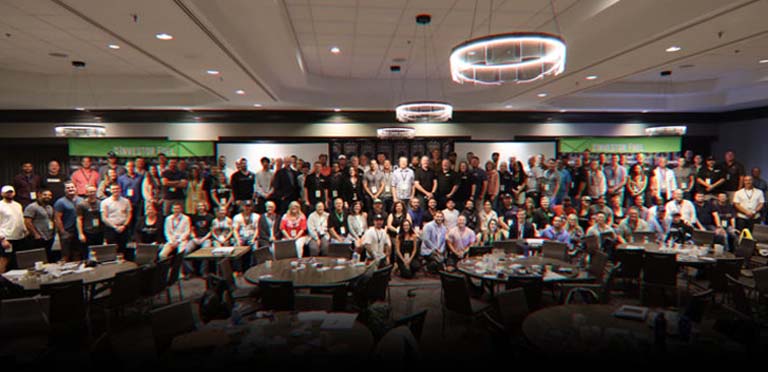
Show Summary
In this conversation, Cody Stegeman shares his journey into real estate, starting from a construction background to becoming a successful entrepreneur in the fix and flip market. He discusses the importance of networking, the challenges of starting out, and his transition into multifamily investments. Cody emphasizes the need for hard work, financial literacy, and the willingness to take risks in order to achieve financial freedom.
Resources and Links from this show:
Listen to the Audio Version of this Episode
Investor Fuel Show Transcript:
Dylan Silver (00:01.223)
Hey folks, welcome back to the show. I’m your host, Dylan Silver, and today on the show I have Cody Stegeman in Minnesota, a real estate entrepreneur. Cody, welcome to the show. Let’s talk about your journey into the real estate space. People oftentimes see the success, they don’t see the beginning. How did you get into the real estate space? Was it in your blood?
Cody Stegeman (00:12.974)
Thank you.
Cody Stegeman (00:25.742)
you know, honestly, what ended up happening was I, I had a construction background and I knew I wanted to get into the real estate space. I had some kind of adjacent acquaintances that I had seen had built some very real wealth through real estate. And I kind of, was aspired, aspired to be like them or thought that was the pathway that made sense. so with my construction background, I actually paired with someone else that had some money and I did my first flip. so I actually started out.
rehabbing exclusively when I had first gotten into it. And like I said, I just went the route of partnering with somebody that had some money and then I provided the skills.
Dylan Silver (01:01.351)
So when you’re coming from the construction background, as a lot of people do, was it always in your mind, hey, I’m going to go into the real estate investing space? Or was that not on the radar when you got in?
Cody Stegeman (01:12.782)
It wasn’t on the radar when I initially had gotten in, but as I progressed and like most people, I actually read Rich Dad Poor Dad, which of course I think, you know, it starts a lot of people on this journey funny enough, but it kind of set my sights on understanding that I just didn’t want to work a regular job indefinitely, that I needed to start steering my path towards something that was going to generate some real long-term wealth and allow me to have some time and financial freedom.
Dylan Silver (01:39.069)
So that first flip, you mentioned you partnered with someone. How did you find that person? What was the like building that relationship and how did that first deal come about?
Cody Stegeman (01:47.726)
Yeah. So actually, fun enough, it was someone in my like natural market. Uh, I knew I wanted to get into the space to do it. I just started asking, uh, pretty much everybody I knew hoping that I could find somebody, uh, that was willing to do it. And I actually identified a couple of, uh, potential deals and they were lower price deals. So it was really approachable. mean, the first property we bought, I think we bought it for, it was like 44 or $45,000. You know, so the amount needed down was, was pretty negligible. Um, so yeah, I just started asking people my network.
And I made sure when I presented myself at that point, I had done enough research that I obviously knew what I was talking about in some capacity, just because you can’t start asking people for money if you don’t know what you’re going to do. You don’t have a plan. You don’t know how pricing works, right? But yeah, I had educated myself enough at that point. I felt confident that I could reach out to other people to get money from somebody.
Dylan Silver (02:38.141)
So at that point, you’re talking about, let’s do a fix and flip deal. What information are you providing to these people? Let’s do a dive in of this here, Cody, to make it compelling for them. And how did those conversations end up coming about? You mentioned you were asking everybody and everybody. So how did that end up transpiring for you?
Cody Stegeman (02:55.278)
Yeah, so, honestly, initially what I did when I told people, said, Hey, these are the resources that I’ve been diving into. I referenced, Hey, I’ve read these books. I’ve listened to X hours of podcasts. I’ve watched YouTube videos. Like I honestly would start off by referencing, Hey, I have not done a deal yet, but this is all of the content that I have digested. And then I gave them the game plan where I said, Hey, what we’re going to do is we’re going to find a property that is distressed or run down.
And I explained how comping worked. I said, Hey, we’re going to find a place that has this much margin and then we’ll be able to buy it, renovate it and sell it. So I provided as much information as possible. so for me on that first one, I actually had already found that deal that I wanted to make work. so I tried to move pretty quickly because I’d identified the deal and I was like, Hey, these numbers make sense. I had spoken to a realtor. I had him put like a CMA and everything together. So I had actual hard reference materials.
that I brought to these people that I wanted to talk to where I said, Hey, these are the comps. This is what they’re asking. This is what it’s going to cost to renovate, blah, blah, blah. And they kind of presented all of that to them to try to assuage any fears they had from getting into it. And I also too was very vocal that, you are the first person that gets their money back. you know, obviously after the bank loan where I won’t take a penny before you get your seed money back. Just cause obviously when you’re, you’re operating from a place of a lack of experience.
A lot of times you have to be willing to give up a bigger portion of the deal to get started, which I think sometimes people are averse to, but the reality is getting to do a deal is invaluable. So I mean, if you have to give up the majority of what would be profit just to be able to get to go through the process of the deal, I totally think it’s worth it.
Dylan Silver (04:33.211)
at the deal. Yeah, I’m with you. I mean, I’ve spoken to people, I think people are kind of split on this about, hey, if you lose money and your first deal, look at it as a learning experience. I don’t believe that I believe if your first deal, you should be making money on that first deal. Personally, personally, otherwise, you got to go in knowing, hey, I could lose this money, and I’m okay with it. But no, what I know, all the whole set, I’m not comfortable with that. But I see both sides. So you go
Cody Stegeman (05:01.876)
I think the goal should be to never lose money, of course.
Dylan Silver (05:03.909)
Yeah, you know what I mean? But I’ve spoken to so many people, as I’m sure you have in the fix and flip, where they’ve lost money on their first flip. And so I say, you know, I get it. But Cody, pivoting to this individual who was your first partner in this, you were explaining comping to them. So I’m imagining not a real estate guy or gal. OK, so when you approach them, was it friend of a friend? Was it another contractor with you? How did this what was their avatar? OK, wow.
Cody Stegeman (05:09.845)
yeah.
Cody Stegeman (05:21.912)
Yes.
Cody Stegeman (05:29.932)
it was actually a friend of mine. Yeah.
Dylan Silver (05:33.627)
So oftentimes people are a little bit, I don’t want to say uncomfortable, but proceed with a lot of caution because they don’t want to kind of burn a bridge there. You know, how did you approach it in a sense of were you just like really upfront or was it kind of like a drip campaign with your friends?
Cody Stegeman (05:39.852)
I, for sure.
Cody Stegeman (05:48.59)
No, I honestly, I prefer hyper transparency because even the first time I used a hard money lender, I hadn’t done a ton of deals and I, that relationship I think worked because I told him, Hey, I haven’t done very many deals, but this is what I’m doing. So I think that hyper transparency goes a long way for most people. And like I said, I just presented it as, Hey, this is the data that I have digested. And like, I am very confident in X, Y, and Z. I provided as much information as possible to them.
make them feel comfortable. And of course, I mean, I had a lot of people tell me no as well. You know, I, I am not, I I’ve had a lot of no’s over the years, you know, when presenting like investment opportunities to people. but I think, I think if you’re going be in this space, you have to learn to have this uncomfortable conversations to be willing to hear no.
Dylan Silver (06:35.997)
I think the biggest thing that I’ve noticed is as a salesperson, I’m sales guy before I got into real estate selling cars now, real estate agent, wholesaler. You have to kind of rewire your brain to hear no as not such a negative thing because we all kind of have this. I’m really deep into this sales psychology. We all kind of have this ingrained fear of ostracism or of people rejecting us and like.
Cody Stegeman (06:50.433)
yeah.
Cody Stegeman (07:02.35)
for sure.
Dylan Silver (07:04.345)
If we burn our inner circle, if we go into friends and family and they’re all like, no, that could feel like despair, like what are we gonna do, right? But on the other hand, if we go through everybody and like you said, complete transparency and we get all these nos, then that’s feedback for us that hey, maybe we could tweak this. And then also too, maybe that next person that you ask says yes.
Cody Stegeman (07:25.422)
for Well, I mean, so I actually have a sales background as well. Before I had started this, did copy and printer sales for a while. So I became very, very used to no. And to be honest, I just think of every no is just closer to the next yes. I mean, realistically. So it’s just a matter of reps and not letting it bother you.
Dylan Silver (07:31.869)
wow.
Dylan Silver (07:43.517)
Yeah, that’s 100%. And you know what? It’s easier said than done for a lot of people. That’s why people don’t love, a lot of people say I would never do sales, but then salespeople say that’s what gets us going. Let’s talk about the property that you fixed and flipped, that first deal. So you found the partner, but you mentioned you found the property. How did you find that property?
Cody Stegeman (07:47.301)
hey, that is true.
Cody Stegeman (08:03.314)
so I actually just started asking around. connected with a couple of other, other investors in the area. and I found an agent that some of them had worked with. And that’s actually my recommendation too. Like if someone’s getting started in this, reach out to your local network of investors. A lot of them are very willing to help. and by doing that, I found an agent that had some semblance of an idea of how, you know, real estate investing actually worked just because a lot of agents unfortunately do not understand a lot of those specifics and the inner workings of investing.
But so I connected with that agent, kind of gave him my, my buy box for what I was looking for. And then he just started presenting properties to me and I started underwriting them.
Dylan Silver (08:41.693)
That’s phenomenal. And I completely agree with you. Actually, I have looked into what type of certifications can I get as an investor agent type of deal to kind of bridge the gaps. And I’m sure you’ve seen this that in the investing in the real estate agent and then definitely in my world, the wholesale world, there seems to be almost like, I don’t want to say conflict, but something along those lines. I remember going to real estate school, Cody, and they, people found out that I was a wholesaler, like shock, horror.
Cody Stegeman (08:51.502)
For sure. yeah.
Cody Stegeman (09:08.91)
yeah, it’s For sure. It’s it’s an evil word to some realtors if they don’t understand I’ve it’s so funny because I’ve done some wholesaling as well and it cracks me up. I’ve had agents be like Who what yeah, you know just they hate the idea They don’t understand it and I think that that scares them a little bit and then there’s this Kind of ingrained aversion to it. But yeah
Dylan Silver (09:09.989)
You so you must have some experience with that as an investor interfacing.
Dylan Silver (09:33.073)
Yeah, I would say definitely I’m in Texas, I can’t speak for Minnesota than through the wonderful guests that I’ve had. By the way, every guest that I’ve had in Minnesota, yourself included, has been friendly, has been a great guest. Is there something in the water in Minnesota? Is this just a great place? I’ve never been to Minnesota. Is this, are we gonna see a lot of, is there lot of migration to Minnesota right now?
Cody Stegeman (09:47.786)
It’s just Minnesota nice, I guess, man.
Cody Stegeman (09:56.878)
you know, it seems like it is picking up a little bit just cause the quality of the state is, is really nice. And it actually is one of the best income to cost of living ratios in the U S. yeah. And so, mean, it’s, it’s very deceptive because you know, up here, the dynamic is a little bit different than a lot of the States around us. like trade unions are a little bit stronger and like labor guys make a lot of money. I mean, you know, in a journeyman electrician, I’ll make 80, 90 grand up here in Minnesota. So like it’s yeah.
Dylan Silver (10:07.153)
Really?
Dylan Silver (10:19.165)
Yeah.
Cody Stegeman (10:25.07)
But yeah, it’s a great place to live, honestly. I tell myself that I want to move because of the winter sometime, but I end up just staying here.
Dylan Silver (10:31.869)
The winter’s so cold. I lived in Boston for six years. I lived in New Jersey my whole life until I went to Boston and then now Texas. And I can say I don’t miss the winters. I think they call it snowbird when you go and it’s the summer in the north and then so you might go you might be a snowbird here in the future.
Cody Stegeman (10:44.302)
Yep, that is what they call it, I won’t be against it, man. We had a stretch this last winter where think we had two weeks where it was like a negative 35 plus windchill. And it was insane. mean, I don’t know, it felt like you were gonna die when you went outside. So it was pretty brutal.
Dylan Silver (10:55.537)
Plus the windchill, yeah, it’s like legit negative 50.
Dylan Silver (11:04.125)
Yeah. Have you ever seen I’ve said this on another podcast? I want to say it was like 2016, 17, 18, maybe this this time period. There were these photos and it said, is this the movie the day after tomorrow or is this the city of Chicago? Now, course, Chicago is a different state. But like I was like, yeah, that’s and I feel like Minnesota is right up there.
Cody Stegeman (11:20.758)
Cody Stegeman (11:26.606)
Oh, it is. mean, it’s crazy, man. I mean, this was early March. We got, what was it? think 11 inches of like a random snowstorm at like early March. I mean, it just comes to the territory up here.
Dylan Silver (11:33.981)
Yeah.
Yeah. That’s a whole other level. But pivoting back to your fix and flip journey. So at that point in time, contractor, fix and flip, did your first deal. You get proof of concept, make some money on that deal. You have your investor and friend. You must be on cloud nine after that first deal. What was the next steps for you? What was the next steps?
Cody Stegeman (11:59.638)
Yeah. So I actually, the next step, funny enough, I, I started reaching out to other people, my network that were agents. Cause I was like, okay, I want to build a little bit of like a deal flow, do some more networking. I I’m a firm believer that for most operators, networking is going to be the key to not only deal flow, but finding buyers and good contractors, et cetera, et cetera. and I actually connected with the guy that I had went to school with. I was an agent in a town, a couple hours away.
where I went to school for a couple years and he had a great pocket listing and I decided to say the heck of heck with it and I actually I lived out of my car more or less while I was down there flipping the place. I was sleeping on couches, I slept in my car a bunch, or was commuting back and forth to get the next deal done just so you know we had made some money on that first deal but we still didn’t have a ton of money and we were really trying to try to bootstrap this thing to get it get it going.
But yeah, so we actually transitioned down to that area and did the next deal and I actually that is the area that I now live and operate in.
Dylan Silver (13:00.925)
Wow, okay, so you were all in quite literally in this deal. And so at this point, you talk about practically sleeping out of your car. Walk us through kind of the mind state and your thoughts day to day. That’s a really unique position to be in. What was it like?
Cody Stegeman (13:05.557)
yeah.
Cody Stegeman (13:21.574)
well, there’s a kind of a couple of moving parts. mean, first of all, I think in my mind, I knew that, as long as I was intentional, if I outworked other people, I was going to be able to have success. So, I mean, sometimes, you know, if you, if you can’t be the smartest person, if you can at least try to educate yourself and then outwork other people, you’re going to have success. So that was a big part of that where I just knew I was like, I’m going to put my head down and I’m just going to get this down and I will learn, learn by fire because I want to do something different. I just.
I really wanted to, like you said, establish a life that was more time and financial freedom, just because I’d seen enough people in my sphere of influence and family that that wasn’t the case. the idea of being retiring at 65 only to die a couple of years later and not having lived any life was actually terrifying to me. So that motivated me like crazy, man. It really did.
Dylan Silver (14:10.001)
Yeah, me too.
Dylan Silver (14:14.331)
I’m with you. mean, people talk about working. This is a thing for me is I have been blessed enough and fortunate enough to have traveled and I’ve seen what life is like and, you know, talk about, you you don’t need to be on a beach somewhere, but you can be living basically a free lifestyle where you’re able to do what you want on your own time. And I’d rather do that. And, you know, take Zoom calls and close deals when I’m young than
Cody Stegeman (14:37.669)
for sure.
Dylan Silver (14:44.325)
when I can no longer, you know, go for a run.
Cody Stegeman (14:46.47)
a hundred percent. Yeah. I mean, I always, I always tell people like, yeah, I, I, do work a lot still cause I’m really pushing and trying to grow what we have. But, but I love it. Cause I, if I want to take a two hour lunch and you know, hang out at home with, know, like the wife and the baby or something, I’ll just go take a couple hour lunch. I mean, like there, there is that baked in freedom that you can get to if you, know, you grow stuff and develop stuff the right way.
Dylan Silver (15:08.335)
Absolutely. know, I talk about time freedom. It seems like in your in your story here, you get the first deal, get the second deal. And this is now at this point, you’re full time. Basically, I’m going to be a fix and flipper. Was that the thought process then?
Cody Stegeman (15:22.284)
Yeah, so I actually, was, I was putting full-time hours in the fix and flip, and then was also doing side construction jobs as well to like keep bringing in income to make sure I could keep like, you know, paying my bills, trying to save money. Like, so I was doing both when I first started. It’s called working a hundred hours a week. It’s, it’s
Dylan Silver (15:37.789)
Okay, what does it how that’s even possible?
Dylan Silver (15:43.631)
Okay, so a sample day, like walk us through, wake up time, everything in a day.
Cody Stegeman (15:48.43)
Oh yeah. You don’t wake up, wake up like four 30, five o’clock in the morning. You start working and you essentially work all day. And I would base my rehab activities around if I had dry times or I had to wait on vendors or anything like that. And then you to either sprinkle in other jobs during the day, or I would go help out other, uh, there were other investors that I was doing stuff for at night where a lot of times, you know, 10 o’clock midnight, stuff like that. I’d be doing work and other properties for people. Um, just cause I didn’t, I didn’t have, uh, I had a very like.
whole financial basis personally when I had started. You know, my credit was shot. I didn’t have a lot in savings. Like, I mean, I was young and dumb and didn’t really grow up in a sphere of like a lot of financial literacy. So it’s kind of, yeah, so it’s kind of working, you know, uphill, I guess. And I, that’s what it felt like it took to be able to, you know, I didn’t want to do a flip and take all the money and pocket it. I mean, how was I going to do the next deal? So I was planning on just reinvesting everything we made. So everything I needed to live, I was doing on top of that.
Dylan Silver (16:28.071)
Most don’t.
Cody Stegeman (16:45.74)
And obviously I’m not saying that’s like good or healthy or right for anybody, but I mean, if you’re willing to put in the work, there’s always a pathway to accelerate a process and make it happen.
Dylan Silver (16:55.069)
I shoot, I’m with ya. I am with ya. I feel like, you know, if you’re not willing to, I hate to say it, but if you’re not willing to go all, all in and risk it, you might not get it. You might not.
Cody Stegeman (16:57.934)
Hahaha
Cody Stegeman (17:07.79)
Oh, for sure. Well, I mean, if you know, there’s that quote of if you want to have things that other people don’t have, you have to be willing to do things that they’re not willing to do. And I mean, that’s really what it boils down to. Unfortunately, a lot of people, you know, they hit that 40 hour mark and they kind of want to tap out for the week. And especially in today’s climate, I think if you really want to get ahead, you’re going to have to put an extra effort on, fortunately.
Dylan Silver (17:28.603)
Yeah, yeah, that your story out does mine by a large margin. I would love to be on the fix and flip space doing what you’re doing. That sounds like a real hustle right there. But on my end, when I was I had gotten a couple wholesale deals done at the end of last year into this year and then had saved up enough money to put myself to real estate school. But I only had a set period of time and they recommend that you do it over like a period of months. And I’m like, no, I’m going to get this knocked out in three weeks. Yeah.
Cody Stegeman (17:55.778)
You’re like, I need to get this done.
Dylan Silver (17:57.789)
And they’re like, well, we actually don’t recommend that because it’s going to be 14 hour days and you live an hour away. So I was waking up not at not at that time, but I’d be waking up at like 6 a.m. driving there, getting there at, 730 that time getting settled in 8 p.m. up until 10 p.m. where my classes for three full weeks. And then I would drive back and I would get back at like 11 roughly.
Cody Stegeman (18:18.903)
I love it.
Dylan Silver (18:23.065)
And dude, when I tell you that, was like, dude, I might die. That’s what I was thinking. I was like, I could stroke out and die doing this, but at least I gave it my full effort and I made it through it.
Cody Stegeman (18:26.862)
HAHAHAHA
Cody Stegeman (18:32.856)
Hey, I love that though, man. I guess most people aren’t going to be willing to do that. And I think like we were just saying, if you want to get ahead, like you got to be willing to do the extra effort. So I know that’s great. I love hearing that.
Dylan Silver (18:43.549)
That’s that was my actual thought, Cody, because one of one of those mornings I was like, dude, my actual body doesn’t feel like can take much more of this. But hey, if if I die, then at least I was trying to make it in the real estate. Yeah, that’s right. God bless. But expanding to the business. Right. So your first two deals, you’re finished with those first two deals. Massive weight off your chest. Second deal was, you know, talk about.
Cody Stegeman (18:53.742)
Die trying, right? That’s funny.
Dylan Silver (19:11.259)
working round the clock, living there practically. At that point, you’ve done two deals. You found the deals. You found the partners. You flipped it. What was the next step? Were you like, hey, I’m going to keep doing this. I’m going to do multiple flips. How did the next steps progress for you?
Cody Stegeman (19:26.626)
Yeah. So the transition after that actually went into, starting to rehab more places, but then also sprinkling, sprinkling in, some small multifamily. so basically the progression was, you know, we kept doing flips. you know, I was still doing, kind of side work on the side as well. Cause like I said, I was looking to reinvest all of my money back into the business as much as possible. just, I didn’t want to take living proceeds out of, you know, out of the flips at that point. Cause I knew it would like, you know,
We’re really new to the growth. and then like I said, doing that and then sprinkling in a small multifamily. And then as we progress, I actually, primarily focus on doing value add right now on small multifamily. I still do a few rehabs a year that we actually like sell. but more of our focus now is actually on essentially flipping small multifamily that’s heavily distressed.
Dylan Silver (20:17.597)
small multifamily, heavily distressed. This is a very niche avatar, specifically in Minnesota. I think you probably have cornered off the market there pretty good. I like it when people are really able to drill down into something. Small multifamily, distressed, Minnesota, how many people are doing that? There’s only so many.
Cody Stegeman (20:38.51)
It doesn’t feel like a ton of people. to be honest, I think a lot of people like the idea of doing these type of things and they’re not that good at underwriting and they’re not very good at like the backend running comps, knowing how to renovate, et cetera, et cetera. So like, you know, having it dialed in, I think you can see a ton of success with it. I love the model. I think it honestly, I think it’s a really untapped sector right now as well. Cause you know, we have higher interest rates, spaces feel kind of competitive and numbers don’t look great. I think there are, there’s a ton of opportunity for places that are.
you know, distressed and under-rented, that you can still get great deals or you can really drive your net worth and have some like really strong cash flowing assets.
Dylan Silver (21:16.327)
Do you have a favorite area of Minnesota to buy in?
Cody Stegeman (21:19.022)
Uh, so Mankato is primarily where we’re buying stuff in right now. Um, but I do have stuff in the tertiary cities around there too. And I mean, they each kind of have their own quirks, but I mean, this area, I really do enjoy it. We get really high quality tenants. Um, and the pricing metrics seem to work really well and it’s really accessible. mean, you know, could, we, bought a house for, well, we’ve bought two houses for under 30 grand in the last, uh, couple months. I mean, you know what I mean? So you can, you can really get into stuff at like really accessible price points as
which is nice.
Dylan Silver (21:49.277)
Yeah, that’s, mean, you’re making me want to go take a look at deals on there. I got to get on the MLS out there, I suppose. I don’t know. Cody, we are coming up on time here. Where can folks go to get a hold of you?
Cody Stegeman (21:52.21)
Hahaha!
Cody Stegeman (22:00.546)
Yeah, for sure. so the two primary places, is my Instagram and YouTube. I don’t have a ton of stuff in my YouTube yet. I just started, just started posting on there and I’ve been trying to post a little more prolifically on Instagram. but those are the two primary places. and then I have links in my Instagram bio as well. if you want to DM me any of questions or you’re interested in, you know, diving deeper with me and, looking at doing something together.
Dylan Silver (22:25.213)
Cody, thank you so much for coming on.
Cody Stegeman (22:27.542)
Hey, thanks for having me. It was great. It was a very fun conversation. Hey, heck yeah.
Dylan Silver (22:30.961)
Absolutely.






